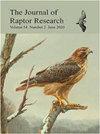美国北维吉尼亚州红隼的高分辨率GPS跟踪揭示了繁殖和繁殖后的范围行为
IF 1.2
4区 生物学
Q2 ORNITHOLOGY
引用次数: 0
摘要
长期监测数据表明,北美红隼的数量持续下降。栖息地的丧失或改变被列为潜在的原因,但关于红隼空间利用的基本信息,包括繁殖范围的大小,是缺乏的。没有一项研究基于任何分辨率的跟踪数据对繁殖红隼的测距行为提供可靠的估计。我们在弗吉尼亚州北部的19只成年雌性红隼的孵化期内安装了太阳能GPS发射器。高分辨率的跟踪开始于17只鸟的早期雏鸟阶段。到繁殖季节结束(8月31日),我们平均每只鸟收集了1710个地点,其中13只鸟在雏鸟的羽化过程中被跟踪。自相关核密度家园范围估计表明,雌性红隼使用的繁殖家园范围(平均为0.32 km2)比大多数先前公布的范围小。在不同的繁殖阶段,红隼的活动范围没有明显的变化,与邻近的红隼的活动范围几乎没有重叠。5只雌鸟在繁殖后期(即雏鸟消失或分散后)将领地转移到离巢箱1.5至12.3公里的地方;它们至少在迁徙期间保持着这些新的范围。我们还记录了所有12只持续跟踪的雌性的家庭范围远足(n = 128)。据报道,鸟类和哺乳动物的平均(4.0公里)和最大(127.7公里)攻击距离相对于活动范围而言是最大的。在雏鸟阶段,以及最终离开其繁殖范围的鸟类,每周的突袭率最高。远途出击行为的存在和多个夏季栖息地的使用对红隼的巢址和栖息地选择数据的解释,以及对该物种在繁殖季节的潜在威胁的评估有直接影响。本文章由计算机程序翻译,如有差异,请以英文原文为准。
High-resolution GPS Tracking of American Kestrels Reveals Breeding and Post-breeding Ranging Behavior in Northern Virginia, USA
Long-term monitoring data indicate a persistent decline in American Kestrel populations across North America. Loss or alteration of habitat have been listed as potential causal factors, but basic information on kestrel space use, including breeding home range size, is lacking. No study has provided robust estimates of the ranging behavior of breeding kestrels based on tracking data of any resolution. We fitted 19 adult female kestrels with solar-powered GPS transmitters during the incubation period in northern Virginia. High-resolution tracking began during the early nestling stage for 17 birds. We collected an average of 1710 locations per bird through the end of the breeding season (31 August), with 13 birds tracked through the fledging of their young. Autocorrelated kernel density home range estimation showed that female kestrels used breeding home ranges that were smaller (average: 0.32 km2) than most previously published range sizes. Home ranges did not vary significantly in size across breeding stages and demonstrated little overlap with the ranges of neighboring kestrels. Five females shifted their territories in the post-breeding stage (i.e., after disappearance or dispersal of fledglings) between 1.5 and 12.3 km from their nest box; they maintained these new ranges at least to the migration period. We also documented home range excursion forays (n = 128) by all 12 consistently tracked females. Mean (4.0 km) and maximum (127.7 km) foray distances were some of the largest reported among birds and mammals relative to home range size. Weekly foray rates were highest during the nestling stage, and for birds that ultimately shifted from their breeding home range. The existence of long-distance foray behavior and the use of multiple summer home ranges, both shown here for the first time for this species, has a direct impact on interpretation of kestrel nest-site and habitat selection data, and on the assessment of potential threats to this species in the breeding season.
求助全文
通过发布文献求助,成功后即可免费获取论文全文。
去求助
来源期刊

Journal of Raptor Research
生物-鸟类学
CiteScore
2.30
自引率
17.60%
发文量
61
审稿时长
>12 weeks
期刊介绍:
The Journal of Raptor Research (JRR) is an international scientific journal dedicated entirely to the dissemination of information about birds of prey. Established in 1967, JRR has published peer-reviewed research on raptor ecology, behavior, life history, conservation, and techniques. JRR is available quarterly to members in electronic and paper format.
 求助内容:
求助内容: 应助结果提醒方式:
应助结果提醒方式:


